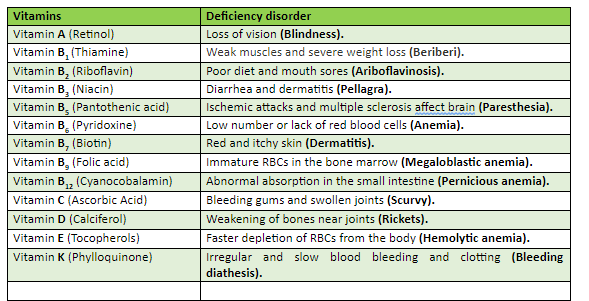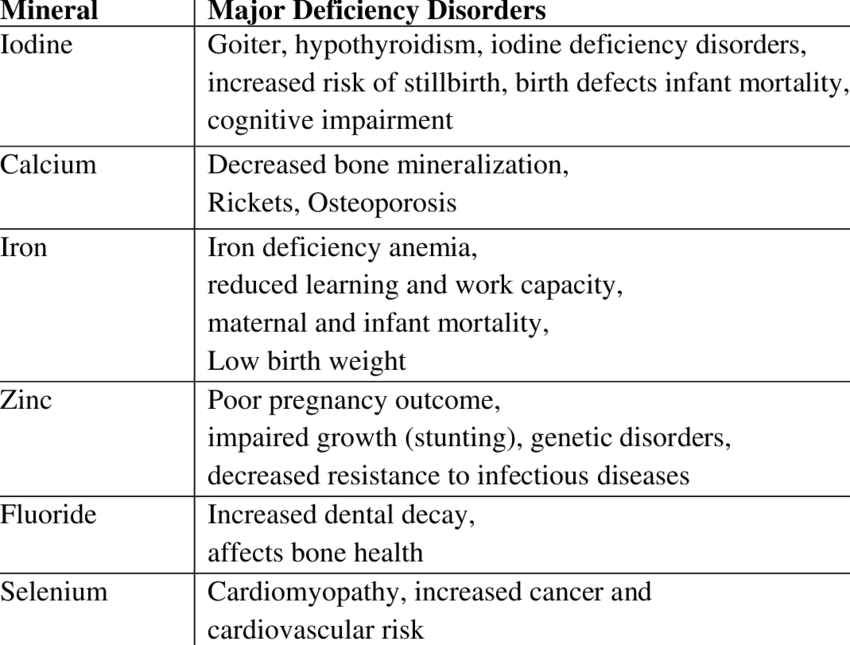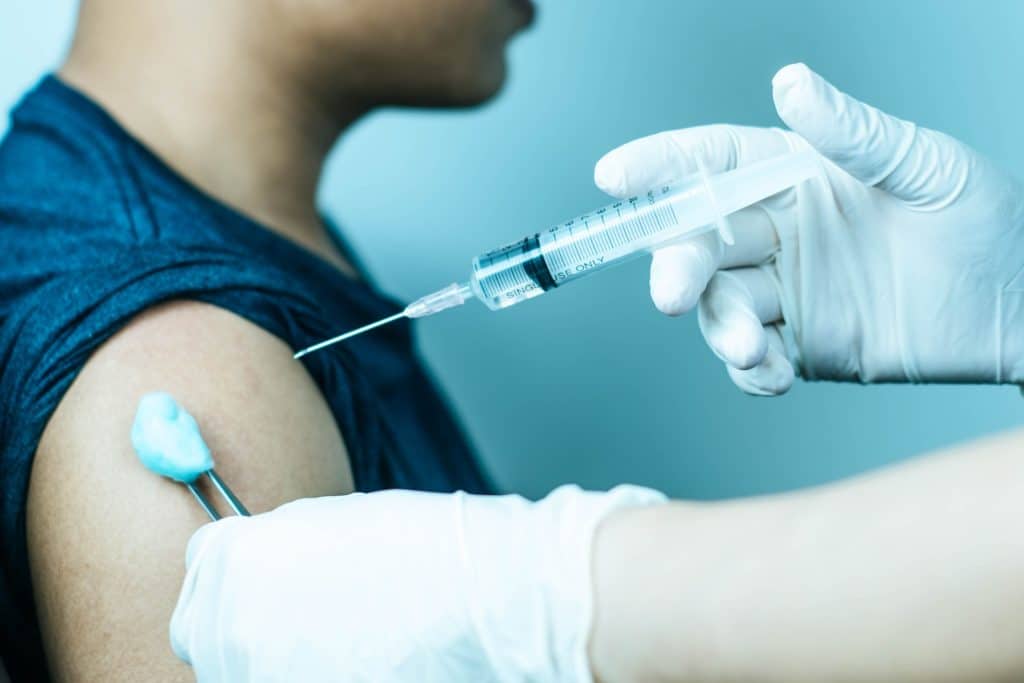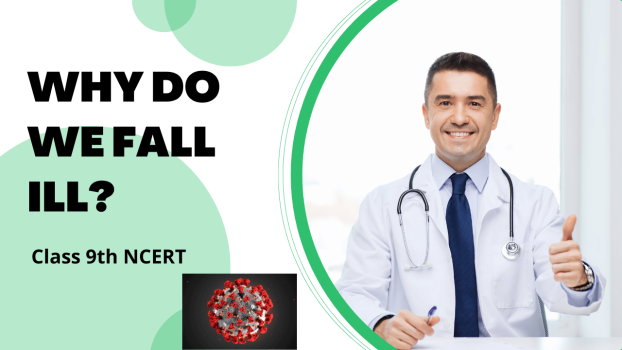We here in the below article are sharing the notes and NCERT Solutions For Class 9th Chapter 13 Why do we fall ill? We are sharing a detailed summary of the NCERT Solutions For Class 9th Chapter 13 Why do we fall ill?
The chapter covers health, diseases, and how to prevent them with a sound health care system and proper knowledge. Why do we fall ill? It is the most basic but detailed Class 9th Science Ncert, and this article will help the students to know the synopsis of the lesson with NCERT Solutions For Class 9th Chapter 13 Why do we fall ill?
Why Do We Fall Ill? Class 9th: Introduction
Health and Disease
Health – A state of physical, mental, and social well-being that includes unity and harmony within the mind, body, and soul of an organism
Disease – Any condition that can lead to discomfort, distress, health problems, and even death of the affected person
Symptoms – Indications of disease, such as headache, stomach pain, nausea, etc., that the patient can only feel
Signs of the disease include fever, vomiting, diarrhea, etc, that a physician can observe
Incubation period – The time interval between infection and appearance of symptoms
Causes of diseases
- Contributory causes
- Unhealthy condition
- Improper public service
- Poverty
- Immediate causes:
These are external causes like micro-organisms.
Organisms like viruses, bacteria, and other micro-organisms can cause diseases in a person.
Based on their duration, diseases are of two types- Acute and Chronic
Acute – Lasts for a short period, e.g. Cold, cough, influenza, etc.
Chronic – Lasts for long periods, eg. Diabetes, kidney stones, etc.
The disease-causing microorganisms that transmit communicable diseases belong to different categories, such as Viruses, which are tiny organisms that grow, multiply, or reproduce only inside the host cells.
Diseases caused by viruses – Influenza, cold (Rhinovirus), dengue, AIDS, etc.
Bacteria – These are unicellular organisms; more significant than viruses
Diseases caused by bacteria – Whooping cough, typhoid, cholera, anthrax, etc.
Fungi – These are plant-like organisms; heterotrophic
Diseases caused by Fungi – Athlete’s foot, candidiasis, ringworms, etc.
Protozoa – These are simple, primitive unicellular organisms that are often found in
water.
Diseases caused by Protozoa – Amoebiasis, kala-azar, malaria, African sleeping sickness, etc.
Multicellular animals like worms are parasites that infect the intestines of human beings and other animals.
Diseases caused by worms- Diarrhoea, anemia, liver rot, etc. Various signs and symptoms characterize the disease.
- Infectious diseases. For example Common cold
- Noninfectious, For example, Cancer
Infectious diseases.
It spreads through infectious agents, including bacteria, viruses, protozoans and fungi.
Bacterial diseases
- Typhoid fever: Salmonella typhi; Widal test is used for confirmation of typhoid
- Pneumonia: Streptococcus pneumoniae and Haemophilus influenzae; it infects the alveoli of the lungs
- Other examples include dysentery, plague, diphtheria
Viral diseases
- Common cold: Spreads through Rhinoviruses
Protozoan diseases
- Malaria: The pathogen is Plasmodium; the malarial parasite requires two hosts: humans and female
Anopheles mosquito; is a malarial parasite that reproduces asexually in the human host while in the mosquito host, it reproduces sexually
- Amoebiasis (amoebic dysentery): Entamoeba histolytica
Helminthes diseases
- Ascariasis: Pathogen is Ascaris
- Elephantiasis or filariasis: The pathogen is Wuchereria bancrofti
- Taeniasis : pathogen is Taenia solium or Taenia saginata
Fungi
- Ringworms: Caused by fungi that belong to genera Microsporum, Trichophyton and
Epidermophyton
Based on causative agents – Infectious and Non-infectious
Infectious – Diseases such as influenza, cold, etc., are caused due to infectious agents.
An infectious disease is classified as communicable because it can be transferred from an infected person to a healthy person.
Non-infectious – Diseases such as high blood pressure, cancer, etc., caused by internal causes such as excessive weight, genetic defects, etc. These are non communicable because it cannot be transmitted from a diseased person to a healthy person.
- Communicable Diseases – Diseases that spread from one person to another, such as
influenza, cold, etc. They are caused by disease-causing microorganisms.
- 2. Non-communicable Diseases – Diseases that cannot spread from one person to another, such as high blood pressure, cancer, etc. These diseases are caused by internal causes such as excessive weight, genetic defects, etc.
Communicable diseases
The disease-causing microorganisms that transmit communicable diseases belong to
different categories such as:
Viruses – These are tiny organisms that grow, multiply, or reproduce only inside the host
cells.
Diseases caused by viruses – Influenza, cold (Rhinovirus), dengue, AIDS, etc.
Bacteria – These are unicellular organisms; more significant than viruses
Diseases caused by bacteria – Whooping cough, typhoid, cholera, anthrax, etc.
Fungi – These are plant-like organisms, heterotrophic.
Diseases caused by Fungi – Athlete’s foot, candidiasis, ringworms, etc.
Protozoa – These are simple, primitive unicellular organisms that are often found in
water.
Diseases caused by Protozoa – Amoebiasis, kala-azar, malaria, African sleeping sickness, etc. Multicellular animals like worms are parasites that infect the intestines of human beings and other animals.
Diseases caused by worms– Diarrhoea, anemia, liver rot, etc.
Why do we fall ill? Class 9th: Means of the spread of communicable diseases
Based on the mode of transmission, communicable diseases are of the following types
Air-borne diseases
Transmitted when disease-causing microorganisms are expelled into the air by coughing, sneezing, talking, etc.
Eg. Common cold, chicken pox, smallpox, pneumonia, influenza, tuberculosis, etc.
Water-borne diseases
Spread when the excretions from an infected person containing causal microorganisms get mixed with drinking water, and this contaminated water is consumed
Eg. Cholera, typhoid, hepatitis A, etc.
Food-borne diseases
Caused by consuming food infected by disease-causing microbes.
Eg. Botulism, stomach infections, etc.
Contact
Diseases spread through coming in contact with the diseased person or using the articles used by him
Eg. swine flu, ringworm, conjunctivitis
Animals
Animals that transfer disease-causing microorganisms from an infected person to others are called vectors. Eg. female mosquitoes can transfer the malaria-causing Plasmodium
Non-Communicable diseases
A non-communicable disease can be caused by nutrient deficiency, malfunctioning body organs (degenerative diseases), and bad habits like drug abuse.
Nutrition deficiency
These diseases are caused by a deficiency of certain nutrients like carbohydrates, proteins, minerals, vitamins, etc. The person suffering from such diseases is called malnourished.
- Carbohydrate and protein deficiency – Leads to marasmus. The body becomes lean and thin, ribs become prominent, and the child suffers mental retardation.
- Protein deficiency – Leads to Kwashiorkor. In this, the belly protrudes out, eyes bulge, and the legs become stick thin.
- Vitamin deficiency – deficiency of different vitamins leads to different diseases.
 4. Mineral deficiency – deficiency of different minerals leads to different diseases.
4. Mineral deficiency – deficiency of different minerals leads to different diseases.

Infectious agents
They are the disease-causing microorganisms that belong to different categories such as Viruses are tiny organisms that grow, multiply, or reproduce only inside the host cells. Some diseases are caused by viruses – Influenza, cold (Rhinovirus), dengue, AIDS, SARS, etc.
Bacteria – These are unicellular prokaryotes that are harmful and beneficial for humans. Some diseases are caused by bacteria – Including whooping cough, typhoid, cholera, anthrax, etc.
Fungi – These are eukaryotic heterotrophic organisms. Some diseases are caused by Fungi – Athlete’s foot, candidiasis, ringworms, etc.
Protozoa – These are simple, primitive unicellular organisms that are often found in water. Some diseases are caused by Protozoans – Amoebiasis, kala-azar.
Multicellular animals like worms – These are parasites that infect the intestine of human beings and other animals Some diseases are caused by worms- Diarrhoea, liver rot, etc.
Communicable diseases
An infectious disease is classified as a communicable disease as it can be transferred from an infected person to a healthy person
Means of disease spread
They are the disease-causing microorganisms that belong to different categories such as:
Air-borne diseases – Transmitted when disease-causing microorganisms are expelled into
the air by coughing, sneezing, talking, etc. E.g., common cold, chicken pox, smallpox,
pneumonia, influenza, tuberculosis, etc.
Water-borne diseases – Spreads when the excretions (from an infected person) containing causal microorganisms get mixed with drinking water, and this contaminated water is consumed. E.g., cholera, typhoid, hepatitis A, etc.
Physical contact – Includes sexually-transmitted diseases. E.g., syphilis, gonorrhea, AIDS,
etc.
Blood-to-blood contact is established during a blood transfusion or pregnancy (between the mother and her baby). E.g., AIDS can spread through blood contact
Animals –Animals that transfer disease-causing microorganisms from an infected person to others are called vectors. E.g., female mosquitoes can transfer the malaria-causing Plasmodium
Why Do we fall ill? Class 9th: Effects of diseases
Local effects – Includes swelling, pain, joint stiffness, etc., that occur only at the site of
infection
General effects – Includes fever, chills, headaches, fatigue, loss of appetite, etc., that occur
all over the body
Inflammation– The process by which the body’s immune system shows the response to
protect the body from infection
Based on the mode of transmission, communicable diseases are of the following types
Air-borne diseases – Transmitted when disease-causing microorganisms are expelled into
the air by coughing, sneezing, talking, etc.
Eg. Common cold, chicken pox, smallpox, pneumonia, influenza, tuberculosis, etc.
Water-borne diseases – Spread when the excretions from an infected person containing
causal microorganisms get mixed with drinking water, and this contaminated water is
Consumed E.g., Cholera, typhoid, hepatitis A, etc.
Food-borne diseases – Caused by consuming food infected by disease-causing microbes.
E.g. Botulism, stomach infections, etc.
Contact – spreads through coming in contact with the diseased person or using the articles used by him
Eg. swine flu, ringworm, conjunctivitis
Animals – Animals that transfer disease-causing microorganisms from an infected person to others are called vectors
Eg. female mosquitoes can transfer the malaria-causing Plasmodium.
Our body gets infected with various diseases when microbes enter our body. However, the body provides resistance to these microbes through various general and specific mechanisms to protect itself.
Why do we fall ill? Class 9th: Specific Defence Mechanism
The functioning of this mechanism involves the following-
- Engulfing of specific pathogens by the white blood cells
- Production of specific antibodies against specific antigens
- Components of specific defense mechanisms.
- White blood cells
- Monocytes: become macrophages on maturation. A macrophage engulfs an invading pathogen.
- Lymphocytes: These white blood cells generate antibodies against the antigens.
- Antibodies: Specific antibodies are generated for specific antigens. The antibodies either prevent the entry of the pathogen into the cell or kill it.
- Sometimes ordinary substances such as pollen-dust, vegetables, and fruits may also act as antigens. The body produces antibodies in its defense, and this causes allergies.
Treatment of Diseases-
Two ways to treat the diseases are-
- Reducing the effect of a disease
- Killing the cause of a disease
- Prevention of diseases
There are some general and specific ways to prevent the diseases
General ways –
- Stay away from the diseased person.
- Ensure a safe drinking water supply.
- Provide a clean environment, which helps in preventing vectors like mosquitoes from breeding.
- Cover your mouth and nose while coughing or sneezing to prevent the spread of the disease.
- Availability of proper nutrition. If proper and sufficient nutrition is not available, the
- immune system of the body will not function properly.
Specific ways-
Vaccination is the body’s protection from communicable diseases by administering some agents that mimic the microbe.
Vaccines are available against many diseases like tetanus, polio, measles, hepatitis B, whooping cough, yellow fever, etc. These vaccines can be prepared from dead germs, live, weakened germs, or live virulent germs or toxoids.

Immunization- The immune system develops strength in the body to fight off microbes. It comprises special cells, proteins, and organs that protect the body against micro-organisms.
Measures for prevention and control of infectious diseases –
Personal hygiene: It includes cleanliness, drinking clean water, etc.
Public hygiene: It includes cleaning of water reservoirs, proper disposal of sewage, etc.
NCERT Solutions For Class 9th Chapter 13 Why do we fall ill?
Q1. State any two conditions essential for good health.
‘Health’ is a state of being well enough to function physically, mentally, and socially.
Therefore, for good health.
(i) One should be disease free.
(ii) There should be social equality and harmony, which are essential for an individual
health, particularly for social and mental health.
Q2. State any two conditions essential for being free of disease.
(i) Remain away from a specific cause for discomfort or disease. For which personal
and public cleanliness and an excellent physical environment are necessary.
(ii) Proper and sufficient food is necessary for the functioning of cells and tissues of the body.
Q3. List three reasons you would think you are sick and ought to see a doctor. Would you still go to the doctor if only one of these symptoms were present? Why not?
Common symptoms which indicate sickness are:
(i) Headache,
(ii) Cough and
(iii) Loose motion.
Even seeing one symptom. I will go to the doctor.
Reason: A single symptom is the sign of a disease. Delaying, it may lead to serious illness.
For example, a headache may mean meningitis.
Q4. In which of the following case do you think the long-term effects on your health are likely to be most unpleasant?
(i) If you get jaundice.
(ii) If you get lice.
(iii) If you get acne.
Why?
Jaundice is a chronic disease that takes a long time to cure. Moreover, jaundice affects the whole body, and it takes a long time to be healthy.
Q5. Why are we usually advised to cook bland and nourishing food when sick?
Infectious diseases show a lack of success in the body’s immune system. For the functioning of the immune system properly, sufficient nourishment and easily digestible food are necessary for a sick person.
Q6.What are the different means by which infectious diseases are spread?
Infection-causing microbes travel from patient to person through:
(i) Air: Sneezing or coughing since little droplets are thrown that reach another person
through the air. For example, familiar Cole, pneumonia, etc.
(ii) Water: contaminated water carries disease-causing microbes, which cause infection during its usage. Examples are diseases such as cholera.
(iii) Sexual contact: Diseases such as syphilis or AIDS are transmitted by sexual contact from one person to the other.
(iv) Animals: These are intermediaries, called vectors, transmitting diseases from a patient to the host. For example, mosquitoes (Female Anopheles mosquito) cause the spread of malaria.
Q7. What precautions could you take in your school to reduce the incidence of infectious diseases?
(i) Preventing overcrowing classes,
(ii) Providing safe drinking water,
(iii) Cleanliness on the school premises and also in the classroom,
(iv) Use of a handkerchief or towel while an infected student is sneezing or coughing,
(v) Use of clean toilets,
(vi) Not to allow water to stagnate in school or around the school to avoid mosquito breeding,
(vii) To get vaccinated whenever programmers organized for inoculation against various diseases.
(viii) Not eating food exposed to flies, mosquitoes, etc.
Q8. What is immunization?
Introduction of a mild type of infection (microbes) or killed infectious microbes into the body by vaccination / by other means to activate the immune system against a particular infection/disease is called immunization.
Q9. What immunization program is available at the nearest health center in your locality? Which of these diseases are the major health problems in your area?
Immunization program-
(i) BCG vaccine against tuberculosis.
(ii) Polio drops against polio.
(iii) Vaccination against chicken pox.
(iv) Vaccination against Hepatitis.
(v) DPT vaccination against Diptheria, pertussis (whooping cough), and tetanus.
(vi) Immunisation against measles.
Major health problems are (i) Hepatitis, (ii) Chicken pox, (iii) Tuberculosis, and (iv)Tetanus
Conclusion
We have shared an article related to Class 9th Science Ncert along with NCERT Solutions For Class 9th Chapter 13, Why do we fall ill? to help the students to nurture their concepts and be accurate about how to attempt questions for Why do we fall ill? Class 9th.

